IS TIBET DEVELOPED?
Blogging on the one human right trumping all other rights: 2 of 2
China says it has developed Tibet, and uses its statistics on economic development of Tibet as justification for its repression of civil and political rights, as they are officially secondary, in China’s hierarchy of rights. China has issued official White Papers on its successes in Tibet, to rebut critics of human rights abuses. One example, from 2015, is highly detailed, yet the statistics are all about consumption, not production: “Optical cables have now reached 668 townships and towns in 74 counties, or 97.8 percent of all townships and towns in Tibet, and mobile phone signals cover 5,261 administrative villages. The number of Internet user households has reached 2.177 million, with an Internet penetration of 70.7 percent, and mobile Internet coverage in farming and pastoral areas has surpassed 65 percent.
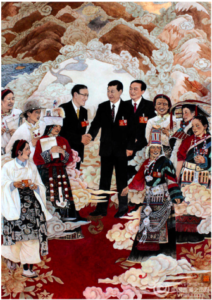 “People’s happiness quotient has been greatly improved. People in both urban and rural areas are living a richer and fuller life as their incomes increase rapidly. In 2014 the per capita disposable income of urban residents reached 22,016 yuan, a 38-fold increase, or an average annual increase of 10.7 percent compared with 565 yuan in 1978; and that of farmers and herdsmen was 7,359 yuan, representing an average annual increase of 10.9 percent. The level of urbanization has also steadily risen. Along with improvements to the people’s livelihood, diversified consumption patterns have appeared, and such consumer goods as refrigerators, colour TV sets, computers, washing machines, motorcycles, and mobile phones have entered ordinary households. Many farmers and herdsmen have become well-off and built new houses; some have even bought automobiles. Radio, television, telecommunications, the Internet and other modern information transmission means, which are at the same level as that of the country and the rest of the world, arenow part of Tibetans’ daily life.”
“People’s happiness quotient has been greatly improved. People in both urban and rural areas are living a richer and fuller life as their incomes increase rapidly. In 2014 the per capita disposable income of urban residents reached 22,016 yuan, a 38-fold increase, or an average annual increase of 10.7 percent compared with 565 yuan in 1978; and that of farmers and herdsmen was 7,359 yuan, representing an average annual increase of 10.9 percent. The level of urbanization has also steadily risen. Along with improvements to the people’s livelihood, diversified consumption patterns have appeared, and such consumer goods as refrigerators, colour TV sets, computers, washing machines, motorcycles, and mobile phones have entered ordinary households. Many farmers and herdsmen have become well-off and built new houses; some have even bought automobiles. Radio, television, telecommunications, the Internet and other modern information transmission means, which are at the same level as that of the country and the rest of the world, arenow part of Tibetans’ daily life.”
In these enumerated ways, China has, it says, fulfilled the human rights of the Tibetans. Consumption is fulfilment of human rights. But what of production? According to this lengthy White Paper –over 14,000 words in English- China has embarked Tibet on “the road to development”, China has built hydropower dams and power grids, railways, highways and urban infrastructure, and there is now an influx of tourists. None of these provide secure employment for Tibetans, or boost rural production, or add value to primary produce, or link Tibetan livestock producers to lowland Chinese markets.
Geographer and ethnographer Emily Yeh provides us with vivid accounts of how China’s development projects impact on the lives of Tibetans. Drawing on first hand fieldwork, she concludes that what China calls development is more accurately called territorialisation. China’s starting point is that: “The Han ethnicity and the industrialized, urban eastern seaboard as the site of developed, modern, high- suzhi citizens, who must lead the way as models for the rural, western, low-quality, backward minorities, of whom Tibetans are the most extreme case. If China is constituted by difference from the West, then Tibet is a difference within that difference. As a periphery in the making, it provides a distinctive and revealing view of the state. As an internal other, Tibetans are positioned as backward and lagging behind, in need of the guidance and benevolence of the Han and the state. Their backwardness must be ameliorated through a series of gifts, first socialist liberation, then development in the form of market rationality, a spirit of hard work and entrepreneurship, urbanization, and civilized housing. Their constant lack and their permanent failure to measure up, whether in their suzhi, scientific knowledge, technical skills, willingness and ability to labor diligently, or desire for capital accumulation, legitimates state development intervention, which enables them to be included in the broader Chinese nation-state. This inclusion is compulsory, as Tibetan belonging to the spatial container of PRC territory is naturalized. Their simultaneous exclusion from the nation-state, as an internal other always in need of improvement, and their compulsory inclusion into the nation-state and its space, marks the topology of the exception that characterizes Tibetan life in the PRC.[1]
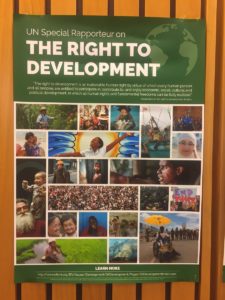
“Migrants [to Tibet from Sichuan] do not act as the bearers of development in the form of technology transfer that state officials claim them to be. The reproduction of socio-spatial distance between Han migrants and local villagers not only precludes the transfer of vegetable cultivation skills, but also makes it easier for the migrants to pass on the risk of vegetable farming to local villagers through unenforceable contracts and the option of simply running away. The migrant farmers also do not act as vectors of development since the income they earn does not stay in the TAR: it is almost entirely sent home as remittances. While in Tibet, the migrants live frugally and build their own mud brick houses, adding little to the circulation of value within the region. Yet they see themselves as contributing significantly to the development of Tibet, drawing on a spatial imaginary of suzhi that posits the east as the direction from which development comes; people from more “developed” areas are assumed to absorb this quality of place, making them more developed subjects. The Han see Tibet as underdeveloped and underurbanized. Even as they are convinced of their own contribution to Tibet’s development, they believe that the state has bypassed their own hometowns, and thus resent state largesse in the form of subsidies poured into Tibet, not recognizing the extent to which these subsidies flow out almost as quickly as they stream in. Instead, they wonder why the Tibetans are not more grateful for development.
“As present and poison, the gift captures the contradictions of housing in particular and development more generally as both desirable and frightening for the relationships and obligations it entails. For Tibetans in Lhasa, the gift of development has brought both access to more commodities and a growing sense of themselves as ra ma lug, “neither goat nor sheep,” no longer known, in a sense, to themselves. The gift of development housing is accompanied by a monetary debt that is transmuted into a deeper debt of loyalty, one that must be constantly performed at the articulation point of sovereign power and biopower. Moreover, any reluctance to perform appreciation and indebtedness becomes a sign of ingratitude; thus Tibetans speak about fearing monetary indebtedness, even when they clearly have the financial means to pay for their new houses.
“Rather than dismiss claims of development as gift, we should take them seriously. The analytic of the gift is useful for interrogating development beyond interstate relations and foreign aid. The grammar of the gift posits an intersubjective relationship between the state as giver and its citizens as recipients; it thus works to produce the effect of the state as a reified, unitary actor with an ontological presence. This reification of the state calls into being the recognition of a relationship of belonging and thus works to consolidate state space as territory.
“Development produces contradictory subjects and complex subject positions. Finally, I have argued that development and landscape transformation are central to processes of state territorialization. Migrant vegetable farming and Comfortable Houses form a trajectory of state incorporation and territorialization that, beginning with the establishment of the state farms in the 1950s, transformed nature in part through the recruitment of Tibetan participants. The transformation of the material landscape has helped advance the project of making the current boundaries of the PRC seem the proper and naturalized geographical container for Tibet and Tibetans.”
[1] Emily T. Yeh, Taming Tibet: Landscape Transformation and the Gift of Chinese Development, Cornell University Press. (2013), 264-8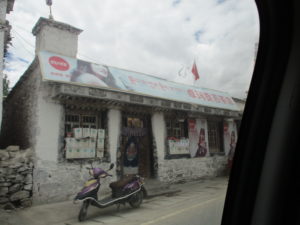
Thus we find ourselves in the present day, where Tibet remains largely underdeveloped and under-invested, and so available to be reimagined, as natural capital, more valuable to China than as production landscape. Although China has urbanised and prospered, with soaring demand for dairy products, wool and other livestock products, little of what is produced in Tibet reaches China’s urban markets, even after six decades of Chinese control.
China has notably failed to develop the Tibetan economy, instead boosting incomes and consumption by transfer payments from the central budget, which is how consumption can rise without a rise in production. The right to development has not, over six decades, been implemented in Tibet, except in the extraction enclaves, where Tibetans are seldom beneficiaries.
China is now testing handheld sat nav devices for pastoralists, linked to the new network of Beidou remote sensing military and civilian use satellites floating above Tibet. These enable pastoralists t o track their animals without having to go see for themselves, excited media stories now say. What they don’t say is this tech also requires each animal to be electronically tagged, and of course the sat nav traffic is two-way, enabling the watchful eye of authority know where the herder is and what he is up to. This is known in Chinese as “the intelligentisation of grazing”.
o track their animals without having to go see for themselves, excited media stories now say. What they don’t say is this tech also requires each animal to be electronically tagged, and of course the sat nav traffic is two-way, enabling the watchful eye of authority know where the herder is and what he is up to. This is known in Chinese as “the intelligentisation of grazing”.
Most Tibetan landscapes are much as they were 60 or 600 years ago, a thousand green plateaus now ripe for redesignation as a common pool resource for the planet, their primary function being carbon capture, achieved by excluding the nomads and their animals, thus growing more grass, thus sequestering more carbon. Tibet’s emergence as a massive store of carbon, made possible by six decades of underdevelopment, also makes Tibet global, part of the global carbon economy, a major part of China’s green credentials. It means the path of development is closed.

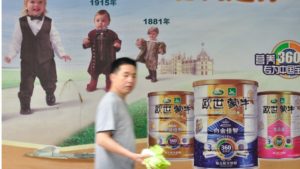
JUST IMAGINE………..
Can we, for a moment, indulge in a fantasy, of what Tibet could have been today, if China had sincerely wanted development, for Tibetans to prosper, by taking full advantage of Tibet’s comparative advantages? The sad part of this fantasy is that not only did this not happen, now it can never happen, as China is shifting to completely different purposes for Tibet, making this fantasy even more impossible.
Across Tibet, on well-made local roads, shiny stainless steel milk tanker trucks rumble through the verdant pasture lands, taking the morning milkings to dairy processing factories, one in almost every county town.  There the fresh milk from dzomo hybrids is processed into yoghurt, whey for fitness folk, cheese for those contemporary tastes, infant formula powder for young mothers, and fresh whole milk packaged on the spot with logos proudly labelling Tibet as the source of purity and vitality. From the dairy factories, owned by pastoralist co-operatives, refrigerated trucks pick up the many products, taking them to rail logistic hubs, to be loaded onto refrigerated rail cars, which reach major Chinese cities in less than 24 hours.
There the fresh milk from dzomo hybrids is processed into yoghurt, whey for fitness folk, cheese for those contemporary tastes, infant formula powder for young mothers, and fresh whole milk packaged on the spot with logos proudly labelling Tibet as the source of purity and vitality. From the dairy factories, owned by pastoralist co-operatives, refrigerated trucks pick up the many products, taking them to rail logistic hubs, to be loaded onto refrigerated rail cars, which reach major Chinese cities in less than 24 hours.  In the cities, urban hipsters are proud to drink Tibetan yoghurt as a health food, spurning the slickly packaged competing products imported from New Zealand and Australia. Tibet has such a good reputation for quality control, in its producer-owned co-operatives, that consumers trust Tibetan dairy products as the freshest and most pure, while avoiding the dairy products from Inner Mongolia, produced by huge Chinese corporations with deservedly bad reputations for cheating customers by adulterating dairy products with dangerous chemicals.
In the cities, urban hipsters are proud to drink Tibetan yoghurt as a health food, spurning the slickly packaged competing products imported from New Zealand and Australia. Tibet has such a good reputation for quality control, in its producer-owned co-operatives, that consumers trust Tibetan dairy products as the freshest and most pure, while avoiding the dairy products from Inner Mongolia, produced by huge Chinese corporations with deservedly bad reputations for cheating customers by adulterating dairy products with dangerous chemicals.
Meanwhile, back in Tibet, it is shearing time for the famous semi-fine wool sheep, whose genetics were improved by crossbreeding with carpet wool and fine wool sheep from colder climates such as New Zealand and Tasmania. The moment a sheep is shorn, its fleece never touches the ground, but is immediately flung across a table, where Tibetan women, with expert eyes, separate the finer wool from the rest, reserving the fine wool of 16 micron diameter or less, for special bales, since they attract much higher prices. Similarly the angora wool goats get their wool treated with great care, because it is so valuable.

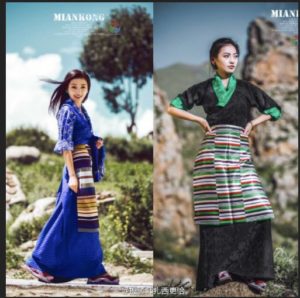





 All wools, having been graded, are baled and sent off by rail across China to woollen mills in Shanghai, as it was in the 1950s, for blending with imported fine wools, to make high quality woollen cloth which will be snapped up by Italian buyers who manufacture high fashion, for women and men, from this prized cloth.
All wools, having been graded, are baled and sent off by rail across China to woollen mills in Shanghai, as it was in the 1950s, for blending with imported fine wools, to make high quality woollen cloth which will be snapped up by Italian buyers who manufacture high fashion, for women and men, from this prized cloth.
Back in Tibet, the pastures are green; flock sizes are managed by co-operatives that grew out of the early land user groups formed by official policy to encourage productivity. Since land is controlled collectively, by effective, elected local collectives, those collectives have the finance to ensure veterinary care. Both traditional herbs and modern medicines are available, and pastoral mobility is maintained, both for productivity and to ensure no pasture is overgrazed. Collectives own trucks capable of carrying livestock considerable distances, in case of local snowstorm disasters, even snow ploughs and bulldozers capable of clearing high passes to rescue animals trapped by an unexpected snowstorm.
The only fences on the vast grasslands enclose fields where fodder crops are grown to help livestock survive the hard winters. When spring arrives, all herders can access local weather forecasts on phone apps, and decide when is the right time to move the herd to fresh green pick, or further, to summer pastures, mingling their yaks,
sheep and goats with wild migrating herds of gazelles and antelopes.
The collective keeps an eye on overall herd size and grazing pressure, pooling herds, each animal tagged by owner, to reduce labour costs and boost efficiency. The collective incentivises each herding family to not keep too many animals, by providing livestock insurance that pays out if there is a snowstorm disaster, enabling herds to be quickly rebuilt. The collective further encourages all herders to take care not to overstock or overstay on any pasture, by operating their own fleet of trucks to take stock to urban saleyards equipped with feedlot grain to keep animals in top condition, and to humane slaughter with the best technology that first makes the animals unconscious.
In many parts of Tibet, in spring, there is a seasonal flush of caterpillar fungus gathering, again controlled by collectives to ensure the gatherers, mostly women, get a fair price. The collectives also educate people to not rely on yartsa gumbu solely for income, and neglect the traditional animal husbandry, because the Chinese craze for yartsa could fizzle any time, as in fact it did in 2015.
Collectives invest heavily in quality control and brand management, including inspection of distributors, wholesalers and retailers, to ensure there is no adulteration. Tibet maintains a high reputation for being clean and green, attracting premium prices for its products.
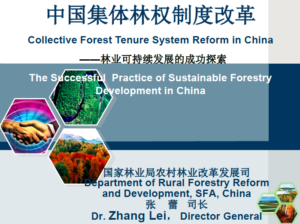
When Chinese miners or dam builders seek access to sites for Chinese projects, they must negotiate with the collectives, and with local governments, staffed by well-educated Tibetans familiar with environmental law, land tenure security law, food security and genetic diversity policies, and constitutional guarantees that the cultivator is the owner, and this applies to pastoralists. Megaprojects can only go ahead if local communities agree, because they are paid royalties, and given vocational training to participate in new employment opportunities.
Because of secure land tenure and the demand for Tibetan wool and dairy products, prospering collectives have no difficulty borrowing money to finance new ventures, upscaling production to keep pace with global competition. Tibet has become part of the global economy, on its own terms.
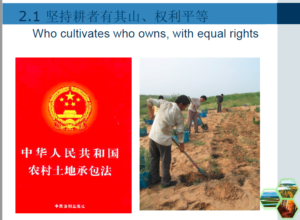
As a result of this rural prosperity, local governments collect sufficient revenues to finance good local schools, health clinics, and health insurance, and inspections of pasture health to ensure there is no overgrazing. Many Tibetan prefectures have strong connections with Chinese forest communities who pioneered local self-management of community resources, with good records in poverty alleviation, resource management and conservation of biodiversity. A prosperous countryside and availability of schooling nearby encourages children and parents to see a future on the land, as was so over so many generations. Monasteries flourish because local communities are prospering, and there is little need for the lamas to seek wealthy patrons from afar.
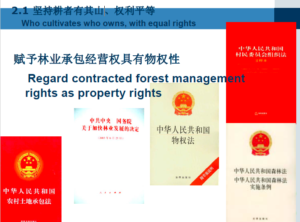 Rural prosperity gives muscle to nominal regional autonomy, giving a strong revenue base to regional governments, and less dependence on subsidies and transfer payments from Beijing. Strong county, prefectural and regional governments, staffed by well-educated Tibetans, defend language status, education and health funding, culture maintenance and development priorities.
Rural prosperity gives muscle to nominal regional autonomy, giving a strong revenue base to regional governments, and less dependence on subsidies and transfer payments from Beijing. Strong county, prefectural and regional governments, staffed by well-educated Tibetans, defend language status, education and health funding, culture maintenance and development priorities.
Lhasa becomes a high fashion hub, with Tibetan designers featuring catwalk displays of high end wool fashions, using latest wool technologies making wool comfortably wearable next to the skin, a full-circle return to Tibet’s traditional outside-in custom of wearing sheepskins fleece in, skin out.
On the catwalk, a must see for fashionistas worldwide, the latest in wool athleisure wear is on parade, even wool as the must-have textile, in a climate changing world, even for firefighters in need of high performance textiles on the firefront that breathe. Wool is so cool. Seriously cool.

BACK TO THE REAL WORLD
That’s our fantasy of where Tibet could be right now. Maybe we got a bit carried away, but it’s all based on reality, just not in Tibet. And the fantasy also tells us why China never took that route. It would make Tibet altogether too autonomous.
Not only did very little of this actually happen in Tibet, it now never could, because China now gazes on Tibet as a post-industrial wilderness, where ecological civilisation is to be arduously constructed by the party-state, a new destiny made possible only by the failure to develop Tibet in line with classic economics, and the idea of comparative advantage. Tibet as ecological civilisation frontier is the topic of further Rukor blogs.
While this fantasy never was and never will be, it is based on what has actually happened elsewhere. Urban China has taken to dairy products, especially yoghurt and infant formula, in a big way; a demand satisfied by imports, and by giant agribusiness corporations based in Inner Mongolia with bad reputations for contaminating their products. Tibet, meanwhile, has gained a reputation among Chinese consumers, as a place of purity. Tibet does produce semi-fine wool but it is never separated from coarser wool, all of which makes only low grade, low priced products, beaten into felt for hats, some woven into carpets. Margaret Atwood reminds us her Handmaid’s Tale is based on what has actually happened, in various places. Same here. Every aspect of our fantasy is based on what actually does happen elsewhere, in China and other countries.
That is what happened to the right to development in Tibet. The failure of development throughout Tibet now leaves it open to new uses, even a new kind of post-industrial economy, converting most of Tibet into national parks for tourism consumption. That major shift would not be possible if Tibet had developed.
WHO DOES HAVE SECURE RURAL LAND TENURE RIGHTS?
A remarkable aspect of the widespread Tibetan loss of secure land tenure, loss of food security, biodiversity and genetic diversity, all without generating production, economic integration and development, is the contrast between grassland and the remaining forests of China.
While China’s grassland citizens have been disempowered, displaced and unable to exercise their nominal right to collectively decide on land use, in the forests there is a very different story. Forest communities across China have been encouraged to see themselves as the owners, users and guardians of the forests, entitled to make economic use of forest resources but also to work with the party-state to achieve biodiversity conservation goals. The contrast is acute. In the forests, China recognises that if human settlements in or close to forests are excluded, fenced out, the disconnect only motivates people to bend the rules and exploit what no longer belongs to them, whenever possible.
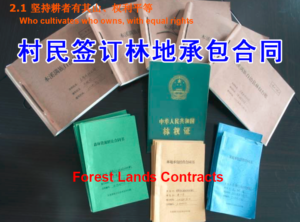 The party-state now treats them with dignity, recognising their rights. Under the Collective Forest Tenure System Reform, jiti linquan zhidu gaige 集体林权制度改革, or linquan gaige 林权改革 everyone works together, productively and sustainably. In short, forest folk are treated like farmers. “Between 2003 and 2013, forestry personnel mobilized in rural communities across the country to survey forest boundaries and facilitate community decision-making processes. Residents in each community would vote on whether to divide collective forests among individual households, adopt a shareholding arrangement, or undertake other forms of collective management.”[1]
The party-state now treats them with dignity, recognising their rights. Under the Collective Forest Tenure System Reform, jiti linquan zhidu gaige 集体林权制度改革, or linquan gaige 林权改革 everyone works together, productively and sustainably. In short, forest folk are treated like farmers. “Between 2003 and 2013, forestry personnel mobilized in rural communities across the country to survey forest boundaries and facilitate community decision-making processes. Residents in each community would vote on whether to divide collective forests among individual households, adopt a shareholding arrangement, or undertake other forms of collective management.”[1]
Oddly, it is China’s National Forests and Grasslands Administration (NFGA) in charge of both, yet the policies are far apart. The National Forests and Grasslands Administration (until 2018 called the State Forests Administration) is in charge of all lands that are not urban or agricultural. This also includes national parks, as the NFGA is also in charge of the National Park Administration.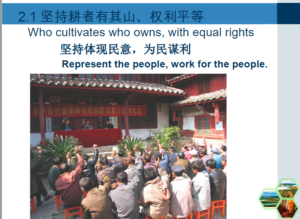
As one would expect, NFGA is in favour of forests, wetlands, biodiversity and national parks; while against desertification, all of which are NFGA responsibilities. A glance at NFGA’s splash page is all you need to know that. But what is NFGA’s stance on grasslands, in the country with the biggest grasslands in the world? That’s not so clear. NFGA administers the Grassland Law of China, which is all about controls, permissions and prohibitions, with almost nothing to say about productive, ongoing pastoralist use. Is there a grassland policy statement, akin to NFGA’s policies, clearly tabbed, for forests, wetlands, parks and deserts? There is nothing much on the website.
In practice, over many decades China has gone from seeing its pastoralists as unproductive, to seeing them as both unproductive and unsustainable. They are problematic, not a solution to anything.
There are now worrying signs that official China feels it went too far in permitting individual forest users rights to effectively own and use forests, and is now looking for ways to disempower forest owners, by persuading them to sell their forest rights so forests can be made into carbon sinks, attracting new players, not only Chinese industries seeking carbon emissions offsets, but also international investors. Once sold, those investors will want guarantees that carbon sequestered in forests will stay in the wood for many decades, locking local forest communities out of ever regaining control. In the name of mobilising resources, opening up markets, encouraging flexibility, forest folk are now pushed to sign away the rights they gained not so long ago, as China, working with the EU and many international donors, learned to respect local communities.
Official policy, for decades, has encouraged grasslands to revert to forest wherever possible, commonly known as the sloping land conversion program, and also “grain-to-green.” Now, it seems the forests are to behave like grasslands, available to global capital as locations for carbon emitters to avoid reducing their emissions. More on this in further blogs.
[1] John Aloysius Zinda and Zhiming Zhang, Stabilizing Forests and Communities: Accommodative Buffering within China’s Collective Forest Tenure Reform, China Quarterly, 235, September 2018, pp. 828–848



